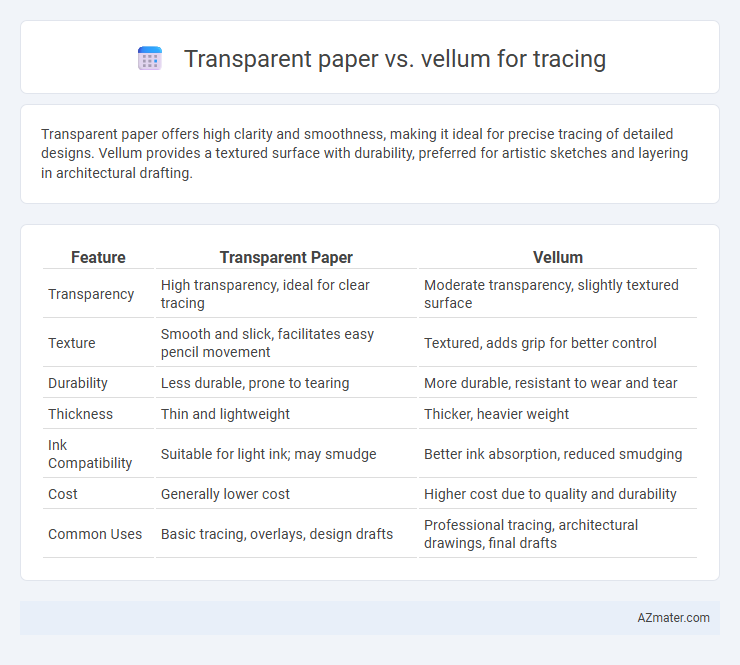Transparent paper offers high clarity and smoothness, making it ideal for precise tracing of detailed designs. Vellum provides a textured surface with durability, preferred for artistic sketches and layering in architectural drafting.
Table of Comparison
| Feature | Transparent Paper | Vellum |
|---|---|---|
| Transparency | High transparency, ideal for clear tracing | Moderate transparency, slightly textured surface |
| Texture | Smooth and slick, facilitates easy pencil movement | Textured, adds grip for better control |
| Durability | Less durable, prone to tearing | More durable, resistant to wear and tear |
| Thickness | Thin and lightweight | Thicker, heavier weight |
| Ink Compatibility | Suitable for light ink; may smudge | Better ink absorption, reduced smudging |
| Cost | Generally lower cost | Higher cost due to quality and durability |
| Common Uses | Basic tracing, overlays, design drafts | Professional tracing, architectural drawings, final drafts |
Introduction to Tracing Materials
Transparent paper offers excellent clarity and smooth surface ideal for precise tracing, making it a popular choice among artists and designers for detailed work. Vellum, known for its stiffness and slightly textured finish, provides durability and a tactile experience suitable for architectural drawings and mixed media projects. Both materials support accurate line reproduction but differ in opacity and handling characteristics, influencing their specific applications in tracing tasks.
What is Transparent Paper?
Transparent paper is a smooth, lightweight material made from cellulose fibers, designed specifically to allow light to pass through for easy tracing of images or designs. It offers a clear view of the original artwork beneath, making it ideal for artists, architects, and designers who need precision and accuracy. Unlike vellum, transparent paper typically has a glossier finish and is less textured, providing sharp, clean lines during tracing.
What is Vellum Paper?
Vellum paper is a high-quality, translucent paper made from cellulose fibers, known for its smooth surface and durability, making it ideal for precise tracing and drafting. Unlike transparent paper, vellum offers subtle opacity that reduces glare while maintaining excellent visibility of the original artwork beneath. Its archival properties and resistance to bleeding make vellum a preferred choice for artists, architects, and designers requiring clean, professional tracing results.
Key Differences Between Transparent Paper and Vellum
Transparent paper offers a smooth, glossy surface ideal for precise tracing and ink work, while vellum provides a more textured, matte finish that handles pencil and charcoal better. Transparent paper tends to be thinner and less durable, making it easier for light transmission but more prone to tearing, whereas vellum is thicker, sturdier, and better suited for repeated use and archival purposes. The choice between transparent paper and vellum depends on the desired texture, durability, and medium compatibility for tracing projects.
Clarity and Transparency Comparison
Transparent paper offers higher clarity with a smooth surface that allows detailed images to be seen clearly, making it ideal for precise tracing tasks. Vellum, while also translucent, has a slightly textured finish that can diffuse light and reduce sharpness, resulting in a softer image visibility. The superior transparency of transparent paper ensures more accurate line reproduction compared to vellum's semi-transparent quality.
Durability and Texture: Which Lasts Longer?
Transparent paper offers a smooth, consistent surface ideal for precise tracing but tends to be thinner and less durable over time, especially with frequent handling. Vellum, made from a more robust and slightly textured material, provides greater resistance to tearing and wear, making it a longer-lasting option for repeated use. When prioritizing durability and texture for tracing, vellum generally outperforms transparent paper in maintaining structural integrity over extended periods.
Ease of Use: Tracing Experience
Transparent paper offers a smooth surface that allows clear visibility of underlying images, enhancing precision during tracing. Vellum provides a slightly textured finish which can reduce glare but may require more pressure from tracing tools. Both materials support accurate line work, though transparent paper is generally favored for effortless, seamless tracing experiences.
Cost and Availability
Transparent paper typically costs less and is widely available in craft stores and online, making it a budget-friendly option for tracing projects. Vellum is generally more expensive due to its higher quality and unique texture, but can be found in specialty art supply shops and select online retailers. Both materials vary in price depending on brand and thickness, but transparent paper remains the more accessible choice for everyday tracing needs.
Best Uses for Transparent Paper and Vellum
Transparent paper excels in tracing detailed designs and architectural plans due to its smooth surface and high clarity that allows precise line visibility. Vellum's slightly textured finish is ideal for artistic projects, such as sketching and calligraphy, offering better ink absorption and durability. Both materials serve distinct purposes, with transparent paper suited for accurate technical tracing and vellum preferred for creative, tactile applications.
Choosing the Right Tracing Paper for Your Project
Transparent paper offers high clarity and smooth texture ideal for precise tracing and overlays, while vellum provides a slightly textured surface that enhances pencil grip and adds durability for repeated erasing. Choosing the right tracing paper depends on your project's needs: opt for transparent paper for detailed line work and digital scanning, or select vellum when working with charcoal, graphite, or mixed media requiring sturdier support. Evaluating factors like opacity, texture, and compatibility with your chosen tools ensures optimal results.

Infographic: Transparent paper vs Vellum for Tracing
 azmater.com
azmater.com